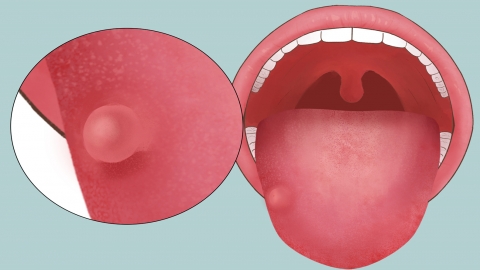What causes a baby's tongue to appear dark red with a purplish tint, and what should be done about it?
Under normal circumstances, a baby's tongue appearing dark red with a purplish tint may be caused by excessive sucking, dietary pigmentation, oral inflammation, congenital heart disease, or Kawasaki disease. Parents can choose appropriate methods such as daily care, medication, or surgical treatment based on the specific situation. Detailed analysis is as follows:

1. Excessive Sucking
When babies suck too hard during breastfeeding or bottle-feeding, local blood circulation in the tongue may temporarily become impaired, leading to a dark red or slightly purplish appearance. Reduce the duration of each feeding session and offer a small amount of warm water after feeding. Monitor changes in tongue color.
2. Dietary Pigmentation
Consumption of deeply colored foods or medications—such as purple dragon fruit puree or iron-containing oral solutions—can cause pigments to adhere to the tongue surface, resulting in a dark red or purplish hue. Discontinue the suspected food or medication and gently wipe the tongue with warm water; the discoloration will gradually fade.
3. Oral Inflammation
Bacterial or viral infections may trigger oral inflammation, causing congestion and swelling of the tongue mucosa, which appears dark red or purplish. This is often accompanied by irritability and refusal to feed. Under medical guidance, treatments such as Xiguashuang spray, Kaihoujian aerosol, or nystatin tablets may be used. Maintain good oral hygiene and clean the baby’s mouth promptly after feeding.
4. Congenital Heart Disease
Abnormal heart structure leads to circulatory problems and reduced blood oxygen levels, causing the tongue to appear dark red or purplish. This is often associated with rapid breathing and delayed growth and development. Medications such as digoxin oral solution, spironolactone tablets, or furosemide tablets may be prescribed under medical supervision. In severe cases, surgical interventions like ventricular septal defect repair or atrial septal defect closure may be required.
5. Kawasaki Disease
An abnormal immune response causes vascular inflammation, impairing circulation and resulting in a dark red or purplish tongue, along with symptoms such as fever and rash. Treatment under medical guidance may include enteric-coated aspirin tablets, intravenous immunoglobulin, and dipyridamole tablets. Regular echocardiograms are recommended to monitor disease progression.
In daily care, parents should closely observe the baby’s feeding behavior and tongue color; maintain oral hygiene to prevent infection; schedule regular pediatric check-ups to detect abnormalities early; ensure proper warmth to prevent colds and reduce the risk of illness.





